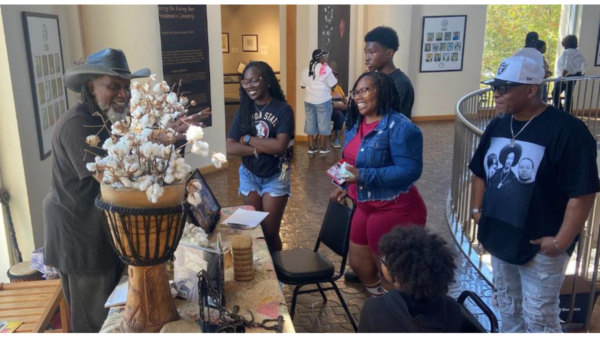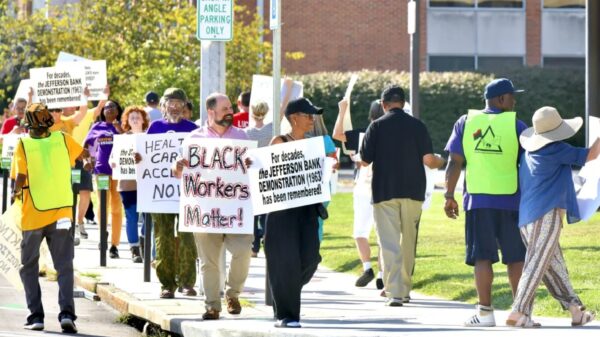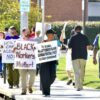
By BOTWC Staff
Throughout history, Black people have displayed incredible resilience in the face of adversity, often forming their own communities as a response to the terrors of racism, segregation, discrimination, and exclusion. These communities were not only places of refuge and unity, but also incubators of culture, art, entrepreneurship, and social change. There were places like Harlem, which birthed an entire Renaissance during the 1920s, marking a cultural explosion for African-Americans and there were other places that literally were created solely for us and by us. Here, we highlight a few historical African-American communities that left an indelible mark on American history and continue to inspire today.
Greenwood (Tulsa), Oklahoma – “Black Wall Street”
In the early 20th century, Greenwood, also known as “Black Wall Street,” was a thriving African-American community with a bustling commercial district. Originally created by Ottawa W. Gurley with the purchase of more than 40 acres in 1906, Gurley sold exclusively to “coloreds only,” creating an economically independent Black community. The residents built successful businesses, including banks, theaters, and shops, that catered to the Black population. Tragically, the Tulsa Race Massacre in 1921 resulted in the destruction of much of the community, but the spirit of resilience and economic empowerment has left an enduring legacy.
Freedmen’s Town, Houston, Texas
Freedmen’s Town emerged after the Civil War as a settlement for formerly enslaved African-Americans. Originally located in Houston’s Fourth Ward, formerly enslaved people traveled along San Felipe Road into the city from plantations south and southwest of Houston, Blackpast.org reports. The community built homes, churches, and schools, becoming a self-sustaining enclave. Despite facing urban development pressures, residents and activists have fought to preserve its historic significance, highlighting the importance of honoring the past while advocating for the future and many of the edifices still exist today.
Sweet Auburn, Atlanta, Georgia
Sweet Auburn was a vibrant Black neighborhood known for its entrepreneurial spirit and cultural contributions. It was home to Dr. Martin Luther King Jr. and the headquarters of the Southern Christian Leadership Conference (SCLC). This community played a pivotal role in the civil rights movement, and its legacy continues to inspire social justice activists.
Bronzeville, Chicago, Illinois
Bronzeville emerged on Chicago’s South Side during the Great Migration, as African-Americans sought better economic opportunities and escape from Jim Crow laws in the South. Historically known as The Chi’s “Black Metropolis,” the neighborhood became a cultural epicenter, fostering the growth of Black-owned businesses, music, and literature. Bronzeville’s influence reverberates through its impact on Chicago’s diverse cultural landscape.
Seneca Village, New York City
Seneca Village was one of the first African-American communities in Manhattan during the mid-1800s. Established before Central Park’s creation, the village was a haven for African-Americans who owned property, stretching from West 82nd to West 89th Street around what is now Central Park’s perimeter. By 1855, Seneca Village had 225 residents, more than two-thirds of them African American. Despite its eventual displacement due to park development, Seneca Village’s history underscores the importance of recognizing and preserving marginalized communities’ stories.
Mound Bayou, Mississippi
Founded in 1887 by Isaiah Montgomery and a group of former enslaved individuals, Mound Bayou became one of the most well-known and successful all-Black towns in Mississippi. The town thrived with businesses, schools, and a strong community foundation. Once a thriving community of business owners and successful farms, it continued to attract large Black populations up until the Civil Rights Movement. Today, it remains an emblem of African-American self-sufficiency and determination with a 98 percent African American population, cementing itself as one of the oldest all African American communities in the nation.
Weeksville, New York
Weeksville was founded by a freedman named James Week who purchased a large plot of land in Brooklyn. It was found after New York abolished slavery in 1827 and was a safe haven for newly freed African Americans, abolitionists and communities united in anti-slavery initiatives. Located in present-day Bed-Stuy, Weeksville was home to over 500 families, many of them doctors, entrepreneurs and business professionals. The community had their own schools, elder care centers, churches, benevolent associations and an orphanage created in 1860. Weeksville was also the birthplace of The Freedman’s Torchlight, one of the first Black newspapers in the United States.
Nicodemus, Kansas
Established in 1877 by a group of formerly enslaved African-Americans, Nicodemus is considered one of the earliest all-Black settlements west of the Mississippi River. The settlers aimed to create a self-sufficient community and marked one of the earliest known accounts of Black people in the westward expansion and settling of the Great Plains, the National Park Service reports. Today, Nicodemus is a National Historic Site and a reminder of African-Americans’ pursuit of freedom and opportunity.
Blackdom, New Mexico
Founded by Frank Boyer and Ella Louise McGruder, Blackdom was the first Black town in New Mexico. By 1908, it had a growing population of about 300 residents and was located fifteen miles south of Roswell, NPS reports. While the exact population of Blackdom is unknown, it is estimated to have been a community of about 150, with popular families including the Boyers, Herrons, Proffits, Collins, Eubanks, Wilsons, and Smiths. Blackdom boasted its own school, church, post office and farms. The dry years of 1917, 1918, and 1922 contributed to the decline of the community, with post World War I crop prices ultimately tanking Blackdom’s farmers. After oil was found in the Roswell Basin, Blackdom residents pooled their resources to form the Blackdom Oil Company, controlling lease rights to a purported 10,000 acres of land. The Roswell Basin fields were eventually found to not be viable and Blackdom didn’t survive the Great Depression.
Allensworth, California
Founded in 1908 by Colonel Allen Allensworth and a group of settlers, Allensworth was the first all-Black Californian township. Founded as a ranching and farming colony for free Blacks, the community was established with the goal of self-reliance and economic independence. Allensworth was home to more than 300 families, home to its own school, bank, and church. The town’s historical site is now a California State Historic Park, preserving its legacy and contributions to civil rights history.
Eatonville, Florida
Incorporated in 1887, Eatonville is the first incorporated all-Black city in the United States. It’s known for being the childhood home of writer Zora Neale Hurston, who drew inspiration from the town’s culture and community for her work. Eatonville was known for its AME church, and the Hungerford Normal and Industrial School, run by Tuskegee Institute graduates, Mr. & Mrs. Russell C. Calhoun. Eatonville continues to celebrate its heritage through events and cultural initiatives and is designated as a nationally recognized historic district
Jackson Ward, Richmond, Virginia
Known as the “Harlem of the South,” Jackson Ward was a vibrant African American neighborhood in Richmond during the late 19th and early 20th centuries. It was a hub of Black business, culture, and entertainment, featuring numerous theaters, clubs, and shops. The neighborhood was home to many prominent African American figures including the nation’s first woman bank president and Hollywood star Bill “Bojangles” Robinson. Considered the birthplace of Black entrepreneurship, Jackson Ward also played a significant role in the Civil Rights Movement.
Soul City, North Carolina
Founded in 1973 by civil rights leader Floyd B. McKissick, Soul City was envisioned as a new planned community that would provide economic opportunities and improved living conditions for African Americans. A WWII veteran, McKissick wanted Blacks to separate themselves to regain economic and political power. Although the project faced challenges, McKissick secured a $14 million bond from the Department of Housing and Urban Development for the community along with millions from the state of North Carolina and private donors. However, people failed to get on board and McKissick was marred by political rumors of corruption and mismanagement. An investigation launched by the General Accounting Office and while they cleared Soul City of any wrongdoing in December 1975, the harm was irreparable and the city was never fully realized. While unsuccessful, its ambitious goals highlighted the importance of self-sufficiency and empowerment.
Hayti District, Durham, North Carolina
Hayti was a self-sustaining African American community that emerged during the Reconstruction era. Located in Durham, North Carolina, Hayti became a thriving hub of Black-owned businesses, schools, churches, restaurants, nightlife, and cultural institutions. Settled by African-Americans looking to work in the tobacco factories in Durham, Hayti boasted two major churches, St. Joseph’s AME and White Rock Baptist. They also had several Black-owned businesses including the North Carolina Mutual Life Insurance Company which helped invest in the community. The construction of the Durham Freeway in the 1960s led to the displacement of much of the community, but efforts to preserve its history persist.
Gullah Geechee Corridor, Southeastern United States
The Gullah Geechee Corridor encompasses a collection of historic African American communities along the southeastern coast, particularly in North Carolina, South Carolina, Georgia, and Florida. These communities are rooted in the Gullah Geechee culture, a distinct African American culture with African influences that developed among the descendants of enslaved people. Established as a national heritage area by U.S. Congress, these communities continue to celebrate their heritage through traditions, language, and art.
These historical African-American communities were more than just geographic locations; they represented resilience, empowerment, and the unbreakable spirit of unity. They challenged societal norms, fostered cultural growth, and paved the way for progress. Recognizing their importance reminds us of the strength of collective action, the preservation of heritage, and the ongoing struggle for equality.
As we reflect on these historical communities, we must also acknowledge the challenges that many African-American neighborhoods face today, including gentrification, systemic inequality, and inadequate resources. Preserving their legacies while advocating for their well-being remains crucial in the pursuit of a more just and inclusive society. These towns are a testament to the determination, creativity, and strength of African-American communities striving for self-determination and equality during challenging times in American history.
Cover photo: Upholding Heritage and Unity: 15 historical African-American communities that shaped history/Bronzeville, Chicago/The College – Chicago Studies/The University of Chicago









You must be logged in to post a comment Login